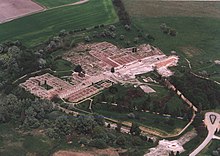Keszthely culture
The Keszthely culture existed in western Hungary between 500 and 700 AD . It was created by Romanized inhabitants of Pannonia who lived in the outskirts of Castellum (now Keszthely ) near Lake Balaton .
This culture flourished under the Avar rule over Pannonia as a center of handicrafts (mainly gold processing).
history
“In Fenekpuszta (Keszthely) ... excavations have brought to light a unique group of finds that suggest not only the presence of Christians, but also of Romans ... There are finds such as a gold pin on which BONOSA was engraved; the proof that a seemingly Roman population remained in Fenekpuszta (after the Great Migration) "
Pannonia , a province of the Western Roman Empire , was devastated in rapid succession by the ( Huns , Gepids , Avars, etc.). Only a few thousand Romanized Pannonians survived this devastation, mainly around Lake Pelso (now Lake Balaton ) in small fortified villages like Keszthely .
This residual Roman population in Pannonia created the Keszthely culture . Most of the artistic legacies of this culture were made in the workshops of Keszthely-Fenékpuszta and Sopianae (today Pécs ) on behalf of the Piedi and later Avar lords of the country.
After Pannonia was conquered by the Avars, the Fenékpuszta fort near Keszthely was spared general destruction. The residents paid tribute in the form of food and art objects. After 568 new, Christian and Romanized Pannonians reached the settlement, who had probably fled here from Aquincum (today's Budapest). The Keszthely-Fenékpuszta castle became the center of an urban area measuring 30 km in circumference, the inhabitants of which buried their dead with jewels and clothing of Byzantine origin. They also rebuilt the basilica in the fortress, in which the members of the Romanesque upper class were buried, while their relatives were buried in front of the nearby "horreum" (granary).
In 626, the Avars suffered a heavy defeat at the walls of Constantinople , which was followed by civil war. The leaders of the Keszthely-Fenékpuszta citizenry supported the losing party in these conflicts. That is why the Fenékpuszta fort was later besieged and destroyed by the Avars. The remaining Christian-Roman population came under military pressure. Both Christians and Avars were buried in the grave fields of the 7th and 8th centuries, but in separate places. Their different religions prevented both peoples from mixing. The Christian-Roman population, which developed its own Roman-Pannonian language , was cut off from the other Roman peoples and thus created an independent and characteristic culture, which can be reconstructed from the finds from the cemeteries around Keszthely. The culture was called the Keszthely culture because of the place where it was found . Keszthely was the urban center of the Lake Balaton region because it was located at the crossroads of important long-distance trade routes between the Danube and the Mediterranean.
Towards the end of the 8th century, Charlemagne destroyed the Avar empire and the Franks advanced into the Pannonian lowlands. The Christian-Roman population around Keszthely quickly adopted the customs of Western Christianity, which among other things also includes the burying of the dead without grave goods and makes it difficult to later identify burials of the Keszthely culture. Fenékpuszta castle was repaired again in the 9th century. It offered protection to the remaining Avars and some southern Slavs who had immigrated there at the beginning of the century. Their cemeteries retained a large part of pagan traditions. The 10th century is the darkest period in Keszthely's history. There are neither traces of a surviving Pannonian-Roman population nor traces of the conquering Magyars .
Handicrafts
At the end of the 6th century, a Romanesque population can be found mainly in the newly built row graves of Keszthely (Castellum) and Pécs (Sopianae) (southwest Hungary ). In the Avar period of Pannonia, new Romanized or Byzantine populations from the Balkans probably reached these places and helped to set up an art production. At all times the Romanesque population maintained an artistic exchange with the Mediterranean world.
The characteristic costume of the women included earrings with basket-shaped pendants, round brooches with early Christian motifs, and dress pins. The early Christian symbols were mainly crosses; and there were bird-shaped brooches and robe pins with bird motifs. The Romanesque population was also subject to an "avarisation", so that an "island" of the late antique tradition can only be found in the immediate vicinity of Keszthely.
language
The name of the village Keszthely could represent a continuity to the Latin "castellum" (fort, castle).
The linguists Magdearu Alexandru (in Românii în opera Notarului Anonymous ) and Julius Pokorny (in Indo-European Etymological Dictionary ) write that the word "kestei" (as Keszthely is pronounced in Hungarian) is similar to the Venetian / Istrian "caestei". The extinct language of these Pannonian novels is still reflected today in several toponyms around Lake Balaton.
literature
- Magdearu, Alexandru: Românii în opera Notarului Anonymous . Centrul de Studii Transilvane, Bibliotheca Rerum Transsylvaniae, XXVII. Cluj-Napoca 2001.
- Mócsy, András. Pannonia and Upper Moesia: A History of the Middle Danube Provinces of the Roman Empire . Publisher Routledge. London, 1974 ISBN 0-7100-7714-9
- Theodor Mommsen : The Provinces of the Roman Empire . Barnes & Noble Books. New York 2003
- Remondon, Roger: La crise de l'Empire romain . Collection Nouvelle Clio - the history and problems. Paris 1970
- Szemerény, Oswald: Studies in the Kinship Terminology of the Indo-European Languages . Leiden 1977
- Tagliavini, Carlo: Le origini delle lingue neolatine . Patron Ed. Bologna 1982



